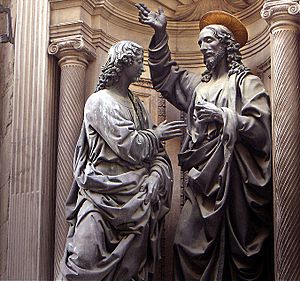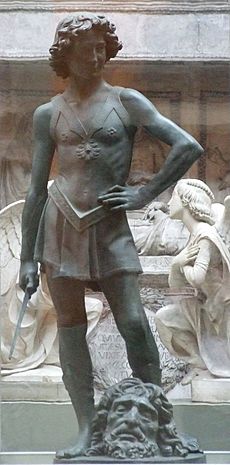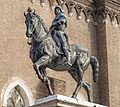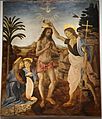Andrea del Verrocchio facts for kids
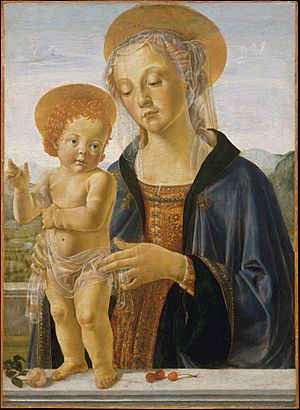
Andrea del Verrocchio (born around 1435 – died 1488) was an Italian sculptor, goldsmith, and painter. He ran a very important workshop in Florence. Many famous Renaissance artists learned their skills or worked in his studio. These included Botticelli, Ghirlandaio, and Perugino. Verrocchio's most famous student was Leonardo da Vinci.
Verrocchio was born in Florence in 1435. His father, Michele di Francesco Cioni, made tiles and bricks. Later, his father worked as a tax collector. He worked for the powerful Medici family, who were famous bankers.
Verrocchio was first named Andrea di Francesco di Cioni. He changed his name to Andrea del Verrocchio when he became an apprentice to a goldsmith named Verrocchio. As a goldsmith's apprentice, he learned to make jewelry and fancy golden dishes. He also learned to hammer gold into thin sheets called "gold leaf." This gold leaf was used to decorate picture frames, statues, and special books. He also learned how to make bronze statues. Verrocchio's bronze statues are his most well-known artworks.
During this time, Verrocchio met Donatello. Donatello became one of the most famous sculptors ever. Both Donatello and Verrocchio created a statue of David with the head of Goliath. They also both made a huge statue of a famous soldier on horseback. Art experts often compare these two pairs of statues.
Contents
Paintings
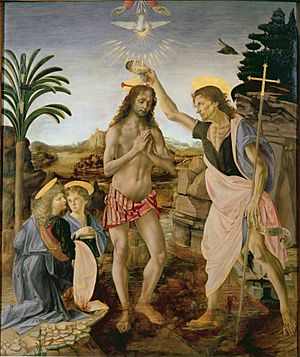
People believe Verrocchio started painting in the 1460s. He worked with the painter Fra Filippo Lippi in Prato. There is only one painting known to be signed by Verrocchio. It is an altarpiece called Madonna and Child with Saints. This painting is in the Cathedral of Pistoia and was made in the late 1470s. Many other paintings came from Verrocchio's studio. These were likely painted by Verrocchio and his students together.
The most famous of these paintings is The Baptism of Christ. It was painted between 1472 and 1475. Giorgio Vasari, a famous writer, said that the angel on the left was painted by Leonardo da Vinci. Vasari wrote that when Verrocchio saw how beautifully Leonardo, who was only eighteen, could paint, he stopped painting himself. If you look closely, you can see that most of the painting uses an old technique called tempera. But the angel, parts of Jesus' body, and the background are painted with the newer oil painting method. This makes art experts think Leonardo worked on many parts of this picture. Some also think that Botticelli painted the second angel.
Sculpture
Verrocchio made two large and beautiful objects from stone: a coffin and a wash basin. He is also thought to have carved a Madonna and Child in low relief. This means it was an almost-flat stone picture.
Verrocchio's most famous sculptures are made of bronze, which is a type of metal. To make a bronze statue, Verrocchio first created the statue in wax. Then, plaster was put over the wax. The wax was then removed, leaving an empty space inside the plaster, like a mold. Metal was heated until it melted and became liquid. This hot, liquid metal was poured into the mold and slowly cooled. Once cool, the plaster was chipped away, revealing the bronze statue inside. The statue then needed to be finished and polished.
Work at San Lorenzo
The Church of San Lorenzo (St Lawrence) was a new church in Florence. It was built by the architect Brunelleschi in the new Renaissance style. The Medici family were the most important supporters of this church. They chose Verrocchio to create three artworks for San Lorenzo.
In 1465, Verrocchio made a wash basin for a room in San Lorenzo. Above the basin, an eagle is carved, which is the symbol of St John the Evangelist. The Medici family's coat of arms is carved on the basin's bowl. Verrocchio then designed a tomb for Cosimo, the famous banker and grandfather of the Medici family.
In the early 1470s, Lorenzo de' Medici asked Verrocchio to design the tomb for Lorenzo's father Piero and uncle Giovanni. The tomb Verrocchio designed was very unusual. He made a large stone coffin, called a "sarcophagus," from beautiful dark red stone. It was decorated with green stone and sculptured bronze leaves. Instead of being placed against a wall, the tomb stood in an archway. Verrocchio designed a bronze net that looks like it's made of rope. This net acts as a screen in the archway, allowing people to see through to the room beyond.
Christ and St Thomas
Orsanmichele is a unique church in Florence. It used to be a corn market. It had a special painting of the Madonna and Child on its wall. The market was turned into a church, and its open sides were walled up. These walls had niches, which are hollow spaces where statues can stand. These niches were big enough for life-sized statues. Many people in Florence worked in different jobs. These workers belonged to groups called guilds. Every important guild wanted a statue of their patron saint in a niche at Orsanmichele Church. Famous sculptors from Florence made these statues.
In 1466, the Guild of Traders asked Verrocchio to make a bronze statue of their saint, St Thomas. Verrocchio created a group of two figures. It shows the most important moment in the story of St Thomas. Jesus stands at the back of the niche, raising one hand. St Thomas stands at the edge, looking at Jesus in surprise. He reaches out to touch the spear-wound in Jesus' side. Verrocchio's statue was admired for how he fit the two figures into the space and how well he told the story.
Around this time, Verrocchio also made a huge brass candlestick for the Palazzo Vecchio, which is Florence's town hall. This candlestick is now in Amsterdam.
David
In the 1470s, Lorenzo Medici and his brother Giuliano asked Verrocchio to make a statue of David. David was a shepherd boy from a Bible story who killed the giant Goliath. He was seen as a protector of the city. Today, there are at least eight statues of David in Florence, with the most famous one by Michelangelo.
When Verrocchio made his statue, the most famous David in Florence was a life-sized bronze statue by Donatello. Donatello's statue shows David naked, except for his boots and hat. The figure stands gracefully, looking down at the giant's head at his feet. It looks very much like an Ancient Greek statue. Verrocchio's statue of David is very different, even though it is a similar size and also made of bronze.
Verrocchio's statue looks like a real boy, dressed in modern clothes. He doesn't stand elegantly. His muscles are tight. He grips the sword handle so tightly that the tendons in his arm stick out. The muscles of his face are pulled into a strange grin, like someone who is very scared. Verrocchio's David has just killed the giant. Now he faces the whole enemy army and wonders what will happen next. The handsome boy Verrocchio used as his model for David is believed to have been Leonardo da Vinci.
The Medici family also asked Verrocchio to make a bronze statue of a Cherub with a Dolphin. This statue was for the fountain at their country home. It now stands in a small courtyard at the Palazzo Vecchio in Florence.
Bartolomeo Colleoni
In 1478, Verrocchio started work on his most famous statue. It is an "equestrian statue," meaning a statue of a man on horseback. The statue was made for the Republic of Venice. It honored a famous soldier named Bartolomeo Colleoni, who had led military troops many times when Venice was at war. Colleoni died in 1475. Many people admired Colleoni, seeing him as a good man, a brave soldier, and a great leader. Colleoni wanted a statue of himself in the main square of Venice. However, the city council did not allow this. The statue was placed in another important square, near a hospital and a church.
When Verrocchio began this statue, only one other large equestrian monument had been made in over a thousand years. Donatello had made an equestrian statue of another soldier, nicknamed Gattamelata. Verrocchio likely studied Donatello's statue, which was in Padua. He also looked at the four ancient bronze horses on the front of St Mark's Basilica in Venice. Verrocchio decided to make his horse do something the St Mark's horses do, but Donatello's horse does not. The horses at St Mark's all have one front hoof raised, balancing perfectly on three legs.
Verrocchio's horse looks like it is moving forward quickly. It is full of action. The figure of Colleoni is not sitting in the saddle. He is standing in the stirrups, as if looking out for the enemy. The horse's head turns one way, and Colleoni's body and face turn the other. Colleoni looks fierce, as if he is leading his troops into battle. The statue is very lively and looks very real.
Verrocchio moved from Florence to Venice in 1488. He went there to help with the casting of the bronze statue. But he died that year and never saw his most famous work finished.
Images for kids
-
Madonna with seated Child (Gemäldegalerie, Berlin)
-
Tobias and the Angel (National Gallery, London).
-
Giuliano de' Medici, c. 1475–1478, National Gallery of Art
See also
 In Spanish: Verrocchio para niños
In Spanish: Verrocchio para niños


